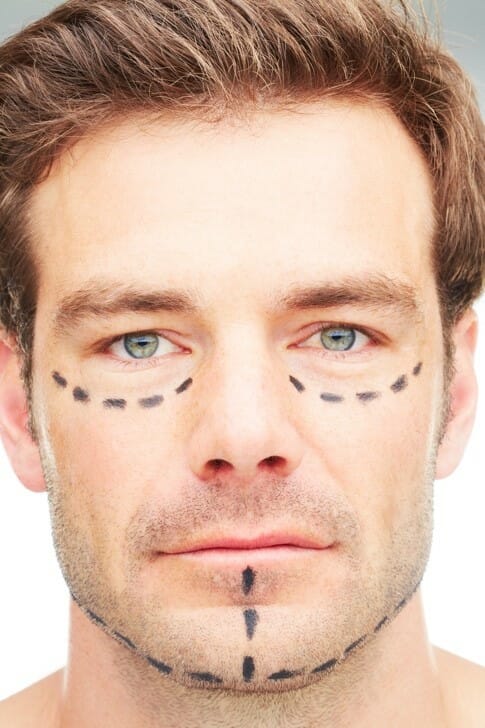
When it comes to facelifts, gender matters
Women aren’t the only ones who want to look younger, and they certainly aren’t the only people opting for cosmetic procedures to accomplish this goal. Once considered a procedure primarily chosen by women, facelifts have experienced a surge in popularity among men in recent years.
Facelifts – more formally known as rhytidectomy – ranked among the top five cosmetic surgical procedures elected by men in 2016, with more than 12,000 procedures performed, according to the American Society for Plastic Surgeons’ 2016 report. There are many factors that have influenced the increase, from the aging of the Baby Boom generation to a competitive workplace that prompts some men to try and reclaim a youthful edge.
The faces of men and women age in similar ways. Both suffer wrinkles as they grow older around the eyes, foreheads and cheeks, although men can be more affected by sun damage because they were more likely to work outside and less likely to protect their skin in their younger years.
Both men and women lose facial volume as they age, which leads to sagging around the cheekbones and bags under the eyes. As time goes on, the jawline become less defined and extra fatty tissue collects under the chin. Eventually, the dreaded “turkey neck” begins, with sagging skin underneath the neck and vertical bands of muscles loosened by gravity and time.
Facelifts aim to tighten and contour the skin and underlying tissue to create a more youthful appearance. But rejuvenating the male face is very different than doing it with the female face, and it is vital to carefully select a plastic surgeon who has experience with male facelifts to achieve the most natural-looking results. Before men decide to have a facelift, they should understand these special considerations:
Hairlines won’t always hide scars. Women can cover a lot beneath their hair, but many men don’t have that luxury. Facelift sutures must be carefully placed because men with short hair or balding palettes don’t have the option of hiding incisions in the hairline. Instead, skilled surgeons often opt to place men’s sutures in natural creases, under the chin, or right at the crease where the ear meets the rest of the head to avoid visible scars.
Facial hair and sideburns complicate matters. Facelifts tend to elevate the sideburn area; in women, that looks natural but in men, it appears awkward and must be avoided. Surgeons must take special care to ensure that facial hair remains in the proper place as well. Incision placement must also consider a patient’s beard and hair follicles to maintain the natural direction of hair growth, especially if the hair is coarse or curly.
Surgeons must also keep in mind that sutures placed too close to the hairline can cause bald spots, as can the formation of thick scars. Of course, facial hair does offer at least one advantage after a facelift: Many patients are pleased that beard growth conceals the pinkness of recovering skin that women might conceal with makeup.
Overtightened skin looks effeminate. Most surgeons agree that it is harder to deliver natural-looking results to men than women from facelifts. Women tend to have features that are more delicate, while men’s faces are more defined and stronger. Men also have natural lines around the forehead and jaw that convey masculinity, and surgeons must carefully avoid stretching the skin too tightly or they will over-feminize a patient’s appearance. Men want stronger chin and jaw lines than women, and that dictates how much skin should be lifted in that area. The best surgeons aim to correct wrinkles and sagging skin with the least amount of stretching and cutting possible.
A risk of excess bleeding. Men have a richer blood supply to their faces than women, and that means facelifts can pose the risk of excessive bleeding or hematomas, a temporary pooling of blood under the skin that creates a purple, bruised appearance. If surgeons unnecessarily disrupt blood vessels in men’s faces, the recovery period can stretch while they wait for the hematoma to heal. Preemptive measures like leaving drains and compression dressings in place longer can help avoid these issues.
Thick skin weighs more. Men’s facial skin is naturally thicker and heavier than women’s, which could lead to some post-surgical settling. Plastic surgeons who are familiar with performing facelifts on men know how to adapt the procedure with anchoring techniques that counteract this effect and leave the least amount of scarring. On the plus side, men’s skin is also coarser than women’s, which can help disguise the appearance of scars.
Men are more private about surgery. While women often appreciate others noticing a more youthful appearance, men tend to be more private about cosmetic procedures. That makes selecting a surgeon who can deliver natural-looking results even more important. Most men will be able to resume social activities within two weeks of surgery, and return to physical activity a week later. Regularly icing the eye area can reduce swelling and bruising faster. Avoiding alcohol and smoking can also speed recovery.
Men can enjoy the same anti-aging benefits as women from facelifts, but the surgery can be quite different. It is important for men to understand the special considerations they face during the procedure. And it is more important to find a plastic surgeon who has the experience with male facelifts to achieve long-lasting and natural-looking results.
Thomassen Plastic Surgery is the top choice for South Florida patients looking for an award-winning plastic surgeon who provides natural-looking results. Contact us for more information about facelifts or the many other procedures we offer.
Share this Post

